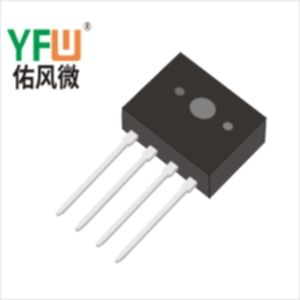Solar panels consist of series-connected PV cells. When a cell or module is shaded or damaged, it can act as a resistor, causing voltage collapse and power loss across the entire string. Bypass diodes mitigate this by diverting current around faulty sections. However, conventional silicon or Schottky diodes introduce forward voltage drops (0.6–0.8V for silicon, 0.3–0.5V for Schottky), leading to energy waste and heat dissipation.
Ideal diode controllers, such as YFW’s innovative designs, replace traditional diodes with low RDS(ON) MOSFETs driven by precision controllers. These devices mimic ideal diode behavior:
Low Forward Voltage Drop: MOSFETs reduce voltage loss to millivolts (e.g., 10–20mV), minimizing power dissipation.
Reverse Current Blocking: Fast-acting controllers prevent reverse current during panel faults or low-light conditions.
Thermal Efficiency: Lower heat generation reduces cooling requirements and extends component lifespan.
For example, YFW’s ideal diode controllers pair with N-channel MOSFETs to create a near-ideal diode, achieving >99% efficiency in high-current applications.
Solar systems often require compatibility with varying panel voltages. YFW’s controllers address this through:
Devices like the YFW-IDC series support input voltages from 3V to 65V, accommodating both low-voltage residential panels and high-voltage commercial arrays. This eliminates the need for multiple controllers, simplifying system design.
For higher voltage ranges (e.g., 100V+), YFW’s controllers can be cascaded with depletion-mode FETs (Qd) to scale voltage handling. This approach, inspired by TI’s LM74610-Q1 design, ensures safe operation while maintaining low losses.
Integrated overvoltage protection (OVP) in YFW controllers safeguards against transient spikes, common in large-scale solar installations. For instance, the YFW-IDC200 features adjustable OVP thresholds up to 80V, ensuring robust system protection.
Circuit Design:
Connect YFW’s ideal diode controller between the PV panel and the bypass MOSFET. The controller monitors the anode (V_anode) and cathode (V_cathode) voltages. When V_anode ≥ V_cathode, the MOSFET turns on, bypassing the faulty section.
Example: In a 48V solar string, the YFW-IDC100 drives a MOSFET with RDS(ON) = 5mΩ, reducing power loss to 0.25W at 5A (compared to 2.5W with a Schottky diode).
Input Voltage Scaling:
For 100V systems, cascade two YFW-IDC100 controllers with Qd FETs. This configuration handles high voltages while maintaining low forward drops.
Thermal Management:
YFW’s controllers include thermal shutdown features to prevent MOSFET overheating, ensuring long-term reliability.
YFW’s ideal diode controllers redefine solar bypass circuit performance by combining low-loss operation, wide voltage tolerance, and robust protection. By replacing traditional diodes with MOSFET-based solutions, solar systems achieve higher efficiency, scalability, and resilience. Whether in residential setups or utility-scale projects, YFW’s innovative controllers are pivotal for maximizing energy harvest and minimizing downtime.
For detailed technical specifications and application notes, visit YFW Diode. 